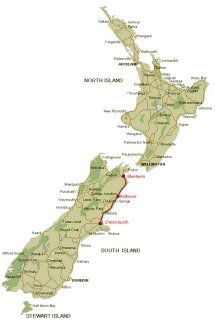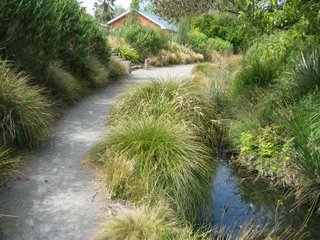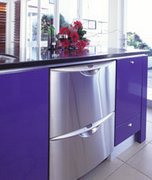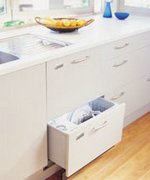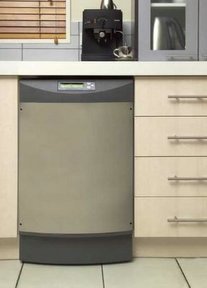Monday, October 23 was Labor Day in New Zealand and my friend Nils and I had high hopes of spending the long weekend tramping in the Alps and exploring the glaciers on the west coast of the South Island. Nils is a physics student from Germany and we had each been planning on traveling independently over the weekend, but we decided to travel together once we realized that the other was planning on traveling as well. However, our plans were hampered by what looked like a weekend of rain across the entire island. New Zealand lies in the “Roaring Forties” (Christchurch is approximately 43.5 latitude) and weather can change quite quickly. Weather reports for the mountains can only forecast out one day due to the speed that weather can change. Winds from the south can bring rain to the east coast of the island, but the west coast can be dry. Winds from the west will dump rain along the coast, but Canterbury will be dry. Or the entire north can be sheltered from the rain by the mountains. So, we decided to be flexible and to decide where we would go just before we departed, based on the most recent weather reports.
As neither of us owns a car, we rented one from one of the many car rental agencies by the airport. For $33 a day, we had a brand new Daihatsu which was boxy and lacked the power to make bold passes on the highway, but which worked out well. The steering wheel was located on the right side of the car and I kept catching myself reaching to my left to grasp the seatbelt which was of course foolish since it was on the right. The car was a manual and so the gearshift was on the left. Fortunately, the order of the gears is the same as a car in the US with the first and second gears being on the left and fifth and reverse gears being on the right. The really annoying thing is that the levers for the directional signals and the windshield wipers are swapped. Whenever you try to signal that you are turning, you wind up turning on the windshield wipers instead of the directional. This is funny for the first half dozen times, but then becomes very, very annoying not to mention dangerous since other drivers may not be able to interpret the windshield wipers tearing across the windshield on as an indication that your car is turning.
one of the many car rental agencies by the airport. For $33 a day, we had a brand new Daihatsu which was boxy and lacked the power to make bold passes on the highway, but which worked out well. The steering wheel was located on the right side of the car and I kept catching myself reaching to my left to grasp the seatbelt which was of course foolish since it was on the right. The car was a manual and so the gearshift was on the left. Fortunately, the order of the gears is the same as a car in the US with the first and second gears being on the left and fifth and reverse gears being on the right. The really annoying thing is that the levers for the directional signals and the windshield wipers are swapped. Whenever you try to signal that you are turning, you wind up turning on the windshield wipers instead of the directional. This is funny for the first half dozen times, but then becomes very, very annoying not to mention dangerous since other drivers may not be able to interpret the windshield wipers tearing across the windshield on as an indication that your car is turning.
This was my first experience driving on the left side of the road in a car and there were several important things to remember. There is the essential rule of looking right for incoming traffic before pulling out, rather than looking left as one would in the US. New Zealand also has a crazy left turn rule where basically, cars turning left must yield to all other traffic. For example, at an intersection, cars turning left have to wait for cars coming from the opposite direction which are turning right, even though the cars turning right must wait for gaps in the oncoming traffic. Rotaries (or roundabouts) are everywhere and of course, you must circle clockwise. According to our AA guide (Automotive Association) cars should have their signals on the whole time that they are in the rotary, but we never saw other cars doing it, but we did see cars pull out in front of us when we did not have our signal on (but our windshield wipers were flying across our windshield like no-ones business).
We picked up our car from the airport and went back to Ilam Village where we both live to check the weather and to consult our maps. We saw that the ONLY sunny place on the whole island that would be sunny was the town of Kaikoura which lies north of Christchurch and so we decided to head there.
To use the word highway to describe the roads that we traveled is deceptive because it conjures images of wide, multilane roads with gentle grades. Not so on the South Island. The “highways” that we drove all had single lanes in each direction. The speed limit was generally 100 km/h (60mph), but this speed was not obtainable when climbing or descending in the mountains where hairpin turns or steep grades made it impossible to go the speed limit, especially for two drivers who had not had a lot of experience driving on the left and were driving a rental car with a high center of gravity. Passing of other cars is common, but tricky on the winding roads. Passing lanes are occasionally offered or slow cars would sometimes pull over to allow the others to pass.
It seems that Kiwis don’t like to spend a lot of money on bridges and why build a two lane bridge when you can get away with a single lane bridge. We would encounter a lot of these, especially on our second day of driving in the north. Signs would warn that you were approaching a single lane bridge and a sign would indicate which direction had the right of way. Sometimes our direction had the right of way, other times it was the opposing direction. The problem was that often you could not see if there were cars on the other side of the bridge due to hills or turns and so you always had to approach the one lane bridges with caution. We got so used to the single lane bridges, that two lane bridges with a lane for each direction of traffic would amaze us. We figured that areas with the two lane bridges were more wealthy communities that could afford the extra lane.
Our route to Kaikoura took us along the east coast and up into the Alps as the mountain range cut across the island towards the ocean. Although we hit “rush hour” leaving Christchurch, by the time we neared Kaikoura and were in the mountains, it was getting dark and there were fewer cars on the road. Kaikoura lies on a peninsula that juts into the Pacific Ocean. At the land end of the peninsula lie the end of the Alps where they meet the ocean. Upon arrival, we followed the signs for the city center and stopped our car at a cluster of buildings. The road paralleled the beach and the air was much colder than it had been in Christchurch. We pulled on jackets and walked along the buildings in search of a restaurant. However, after walking but 100 ft we came to the end of the buildings without much luck. What a small “city center”! This did not look good. Fortunately, my guidebook had a map of the town and we realized that the true city center was a 1/2 mile down the road. The town center was still just a one lane street with most of the restaurants closed, but we were able to find dinner and then a nondescript hostel where we stayed the night.
The town of Kaikoura may be small, but it is a huge draw to tourists due to the depth of the ocean just off the shore. (http://www.kaikoura.co.nz/) Here cold ocean currents from Antarctica meet warm water from the north creating very good conditions for krill to grow, thus attracting sperm whales, Orcas and other whales. The area was heavily settled by Moari in 1000 BC and signs of the settlements can be seen in the surrounding hills. The first European to arrive was Robert Fyffe who set up a whaling station in 1857. More recently, a whale watch company began taking people out to see the whales a few years ago and Kaikoura has been a tourist destination ever since. However, you need not be limited just to boats. There are several companies which will also take people up in small planes to see the whales from above.
We awoke early on Saturday morning because Nils was quite keen on booking a spot on a whale watch. His grandfather had been an ocean explorer and had discovered several new species in the depths of the ocean, but Nils had never been on a whale watch before. The first order of business was finding a bakery or store to buy coffee and bread for breakfast. Once back at our hostel, we called the whale watch offices at 7AM to inquire about the 7:45AM sailing. They told me that the 7:45 was fully booked but that the 10:30AM had space. During the time that Nils and I were conferring, the 10:30 filled up and so we booked spaces on the 3:30.
Since we now had several hours on our hands before the cruise, we decided to drive down to the end of the peninsula to see the place where a colony of seals had taken up residence. The area by the sea was very rocky and cliffs rose up above the sea. There were more tourists wandering about than seals, but we did see an amazing site. We were standing over one of the tidal pools when Nils spied an octopus making its way amongst the seaweed and rocks. The octopus was brownish / redish in color and about two feet long. I have never seen an octopus in the wild before, let alone in a tidal pool. We walked up the cliffs and were rewarded with views of the Alps meeting the ocean. Unfortunately, bad weather was coming and so a haze lay along the ocean and gray clouds were in the sky, but it was a neat view nonetheless.
We decided to head out to Mt Fyffe to walk up  to a lookout which was supposed to be a 1 hour tramp each way. Mt Fyffe is about 1600m high and we saw other tramper with big packs who were planning on going to the top and spending the night. The way up was a wide trail that started climbing right away and never stopped climbing. In the forty-five minutes that we walked, with breaks for photos and for shedding jackets or zipping off pant legs, we climbed a little more than 600m, or better than 1/3 of the way up the mountain. It was a bit more of a workout than we were expecting. The views were nice and we could see the plains descending from the mountains to the ocean below us as we sat on a bench and ate our lunch.
to a lookout which was supposed to be a 1 hour tramp each way. Mt Fyffe is about 1600m high and we saw other tramper with big packs who were planning on going to the top and spending the night. The way up was a wide trail that started climbing right away and never stopped climbing. In the forty-five minutes that we walked, with breaks for photos and for shedding jackets or zipping off pant legs, we climbed a little more than 600m, or better than 1/3 of the way up the mountain. It was a bit more of a workout than we were expecting. The views were nice and we could see the plains descending from the mountains to the ocean below us as we sat on a bench and ate our lunch.
We walked back down (such a steep walk burns the knees) and made our way to the southern side of the peninsula. Her we found outcroppings of layers of rock, jutting from the ocean. It was as if someone had sandwiched several layers of rock, each a few inches thick and then bent then smashed the sandwiches together, causing the sandwiches to break and to jut out at strange angles. Clinging to the rocks were shellfish with round, dark shells that were about an inch in diameter. These creatures were everywhere, but I have not been able to find out what they were. We went up a nearby walk that offered great views of the coast. The mountains ran along the coast and the lush, green hills were all about us. The ocean water was turquoise which made everything quite lovely.
We returned to town to the whale watch company’s offices which are conveniently located next to the train station for the tourist train from Christchurch to Blenheim. Upon arrival, we saw waves crashing on the nearby beach that were over 2m high. Great for surfing, bad for being out in a boat. We discovered that all of the whale watch cruises for the day had been canceled due to rough seas. So, when we had been told over the phone that the earlier cruises were full, what had really happened was that the earlier cruises had been canceled, but they didn’t want us to know that in hopes that later cruises would be able to sail.
After taking some photos on the beach of the massive clouds crowning the nearby mountain peaks, we hopped in the car and drove along the coast to the town of Blenheim, about 2 hours north of Kaikoura. There are only three highways that make the east-west crossing across the South Island and so we had to plan ahead as to where we would go next. Spending the night in Blenheim would put us in a good place to drive west the next day since the weather forecasts showed sun on the west coast.
massive clouds crowning the nearby mountain peaks, we hopped in the car and drove along the coast to the town of Blenheim, about 2 hours north of Kaikoura. There are only three highways that make the east-west crossing across the South Island and so we had to plan ahead as to where we would go next. Spending the night in Blenheim would put us in a good place to drive west the next day since the weather forecasts showed sun on the west coast.
The drive to Blenheim was along the coast with jagged rock formations on our left, and the ocean below us on the right. The rail tracks followed the road and we could see that the train plunged in and out of tunnels as it made its way. The drive was really nice and we soon were in Blenhiem in search of a hostel. We decided on one called Grapes that was in a building that had once been a maternity house. Canoes were available for free to go along the river out back and there was a kitchen for us to make our breakfast.
